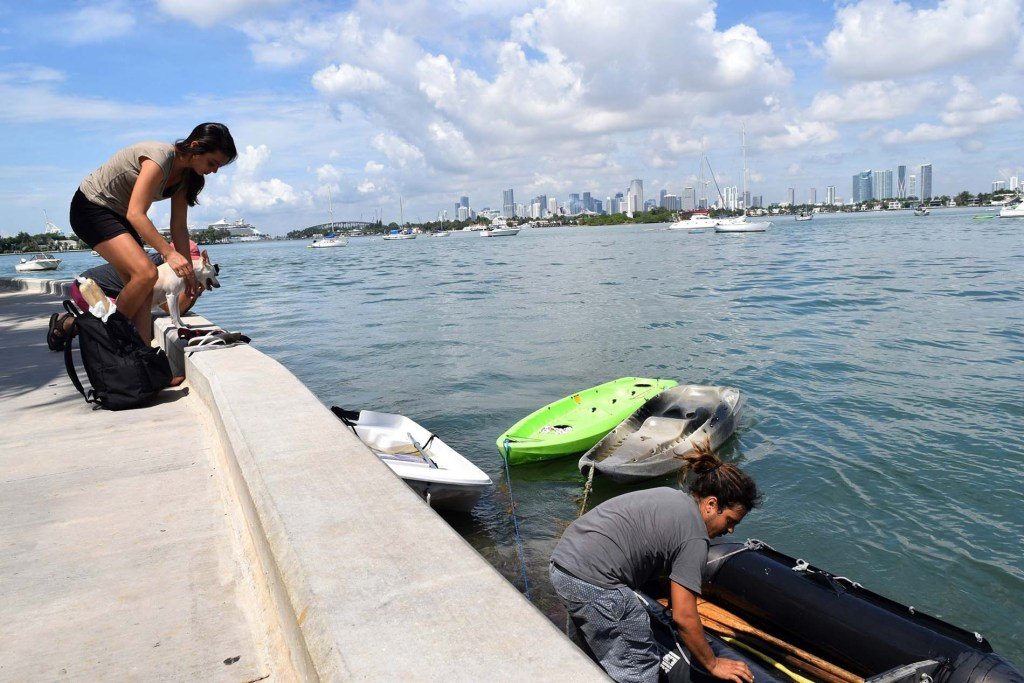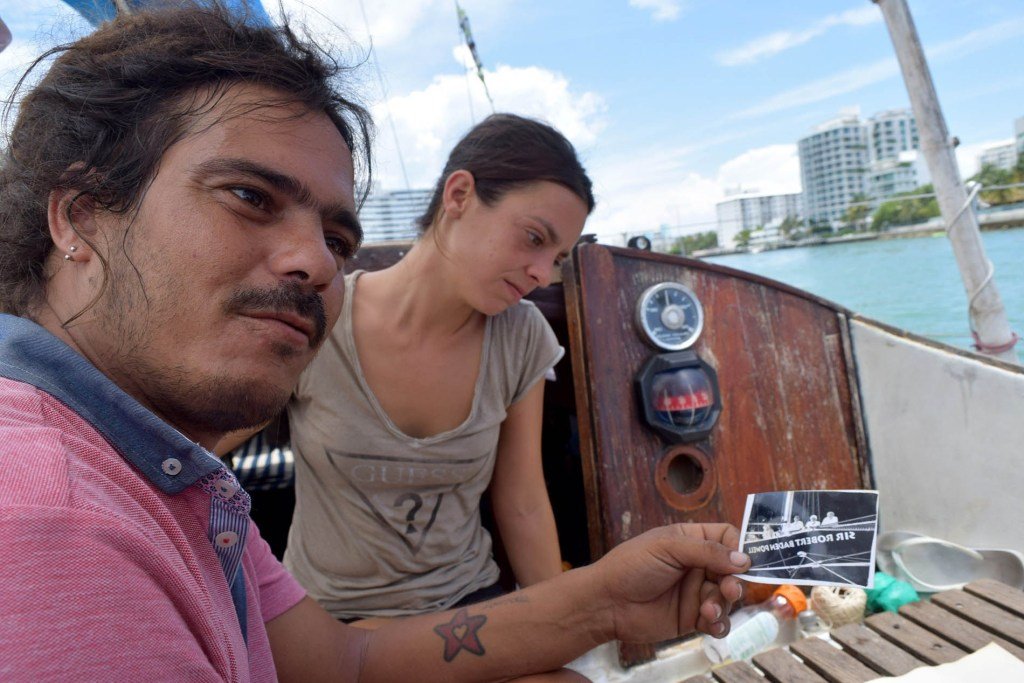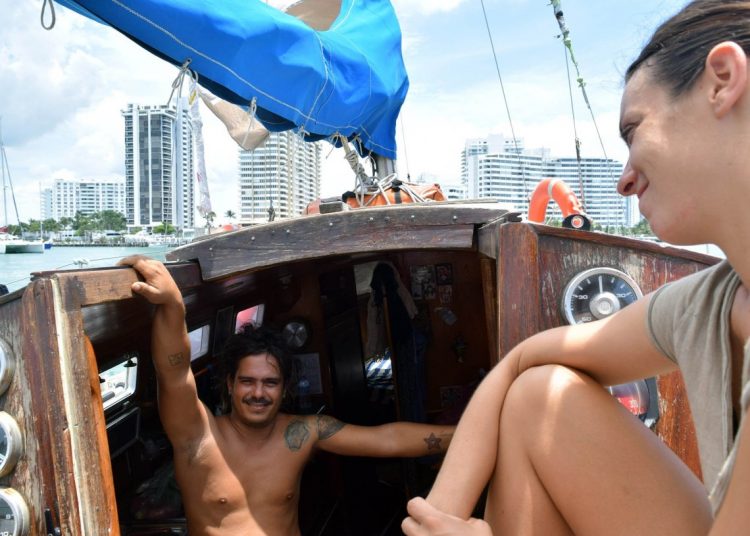The intrepidness of Cuban David Berenguer and his girlfriend, who have just crossed the Atlantic Ocean only with sails and without having studied navigation, also carrying some passengers who hitched a ride on the way, is not a crazy idea but a method to “cultivate spirituality,” according to Berenguer.
The Cuban “captain” affirms that he traveled about 1,700 nautical miles along with his partner, Spaniard Lara Gandía, a native of Valencia, to challenge certain conventions and regulations, such as that an “undocumented” can travel freely with a “documented” boat. Both reached Miami these days after a two-month journey with the wind in favor.
But the Lourdes-Emyca, a 9.15-meter-long sailboat which only has fuel reserves for 300 miles, arrived battered and in need of repairs.
With the anchor cast in Miami’s Biscayne Bay, the boat, manufactured in Germany in 1974, is resting a few meters from a moderately luxurious pier.
“We gave rides to ‘boat’ hitchhiking passengers who wanted to reach America, including a Hungarian Buddhist monk,” Berenguer narrates when he receives EFE on board and while he makes strong coffee to which he adds little sugar.
The other passengers, in addition to the dog Lila, who travels everywhere with the couple, were a Greek citizen who needed miles to get his captain’s certificate, and a Madrilenian who wanted to get to Mexico to start a street art project.
“It was a challenge (Berenguer remains silent as he puts his words in order). In so little space with so many people on board and with different cultures…. But it was nice, we understood each other. The journey to Martinique lasted two months, sailing together,” explains the 33-year-old Cuban.
These passengers got on in the Canary Islands (Spain), but the couple had sailed from the port of Badalona, in Barcelona, and glided across the Mediterranean to the island of La Graciosa.

Lara, who just turned 28, lists by heart the names of the ports they’ve put in, a score.
She does not find words to explain why she did it, until she looks at him and then one sees that it was out of love.
They met last September in Menorca (Balearic Islands), where Berenguer worked temporary jobs with the illusion of buying a boat to visit friends and family scattered around the world.
The journey, although attractive, entailed risks, mainly due to the overcrowded conditions they had accepted, and also with a part of the mast broken in the middle of the ocean, at night and with about three-meter-high waves.
But Lara says she wasn’t scared and neither does she want to think about the return, or the next port, because they still don’t know for sure where they’re going.
“We stopped a lot in the Mediterranean,” Lara recalls.
Badalona, Vilanova i la Geltrú, Castellón, Gandia, Villajoyosa, Cartagena, where the engine ran out and it was necessary to enter the ports, “the first strong adventure,” says Lara. They were all places in the Mediterranean they were leaving behind.
“Then Águila, Garrucha, Cabo de Gata, San José, Almerimar, Línea de la Concepción, Algeciras, Gibraltrar, Morocco and we were already changing, we were leaving the Mediterranean and entering the Atlantic,” Lara explains.
Last December 31 they arrived at La Graciosa at midnight, but since the Canary Islands have one hour less than Spain, they were able to celebrate New Year’s Eve. In Cape Verde they had to decide if they were finally going to cross the Atlantic or not.

“From Cape Verde to Martinique. From there to Puerto Rico, but before that we came to a Venezuelan island along the way, Isla de las Aves, where there’s a bunker with soldiers inside. At first we were a bit scared,” Berenguer continues the story.
His doubt was that, when traveling with a Cuban passport, he would have some problem. He arrived with an asthma crisis to that island that barely appears on the map.
“But they treated me well, they gave me Cuban medicine, they gave me an aerosol and they gave us food. It’s a small island that doesn’t have a single tree. Only sand and a bunker,” he explains.
From there to Puerto Rico and then to Cuba, one of the favorite destinations of the “captain,” who had the bitter experience that the Cuban authorities didn’t let his father, whom he had not seen for five years, go on board, nor even to visit the Lourdes-Emyca.
Berenguer narrates this with pain. He feels a lump in his throat. His father, a former shipbuilder, had been partly his inspiration.
The other was the challenge of touching land in Havana and Miami (Florida) with a Cuban passport, because he left the Spanish one in Spain on purpose.
Berenguer and his girlfriend left Cuba disillusioned. But when they reached the coast of Florida, the authorities gave him a six-month visa and welcomed him.
Now the couple is making a collection on the GoFundMe page, “David Lara Lila, the survivors of the Atlantic,” to continue on their journey without a set destination, with a sailboat that Berenguer bought from an Italian in Menorca without knowing that it had several leaks and that it was almost sinking.
The repair, he says, cost him endless problems.
For the Cuban, who studied Plastic Arts and in addition to sailing is a photographer of people and landscapes with a box camera, recruiting a sailor is very difficult, hence he has been very lucky on this trip (he says it because of Lara).
Finally, she can explain why she made the trip. “These are the things that come up in life, and because first of all I met him. Between one hitch and another…. We met just before sailing,” says the young blue-eyed Spaniard.
EFE / OnCuba









